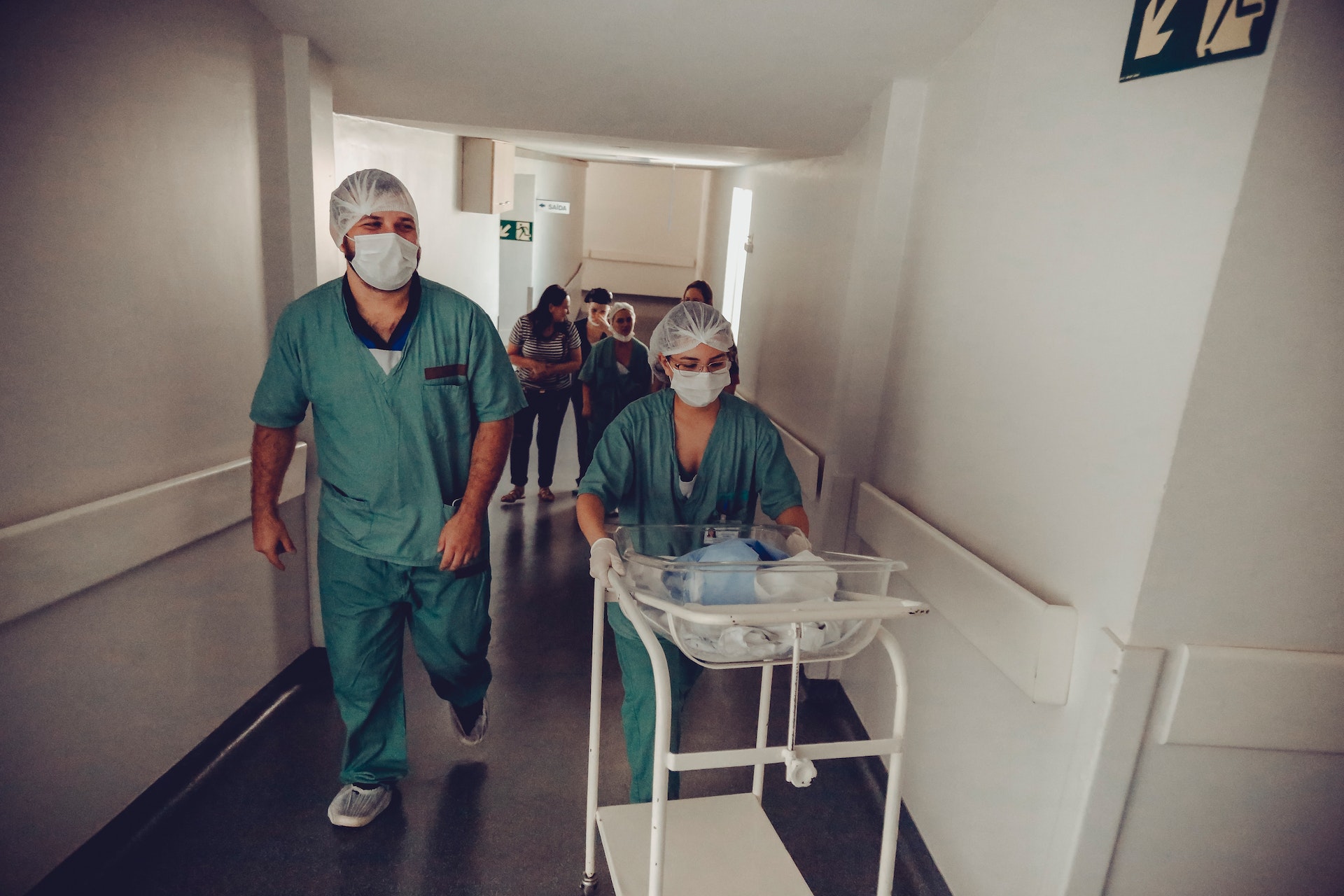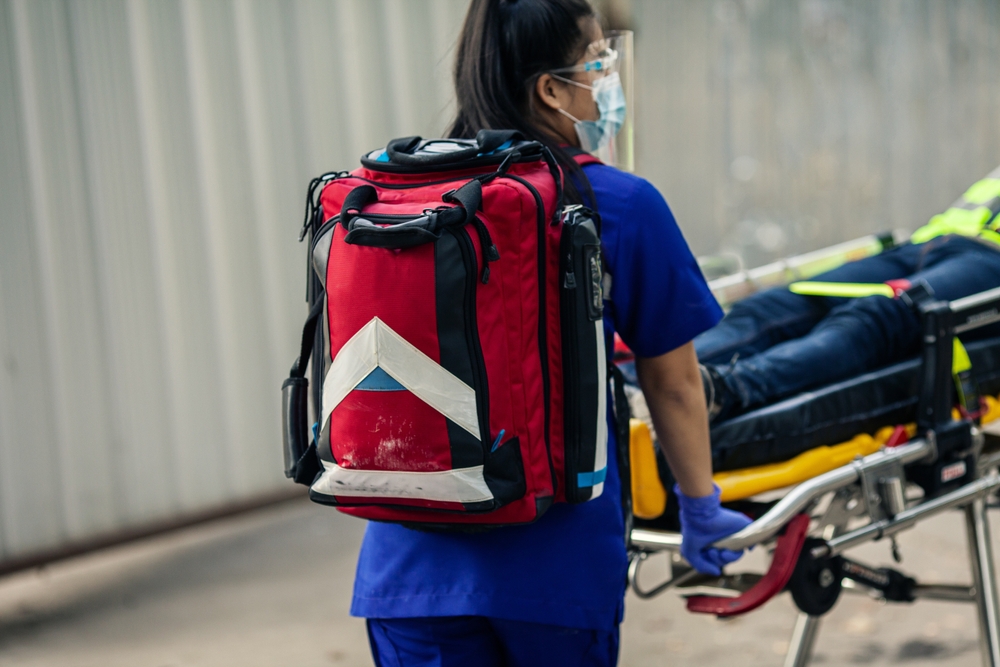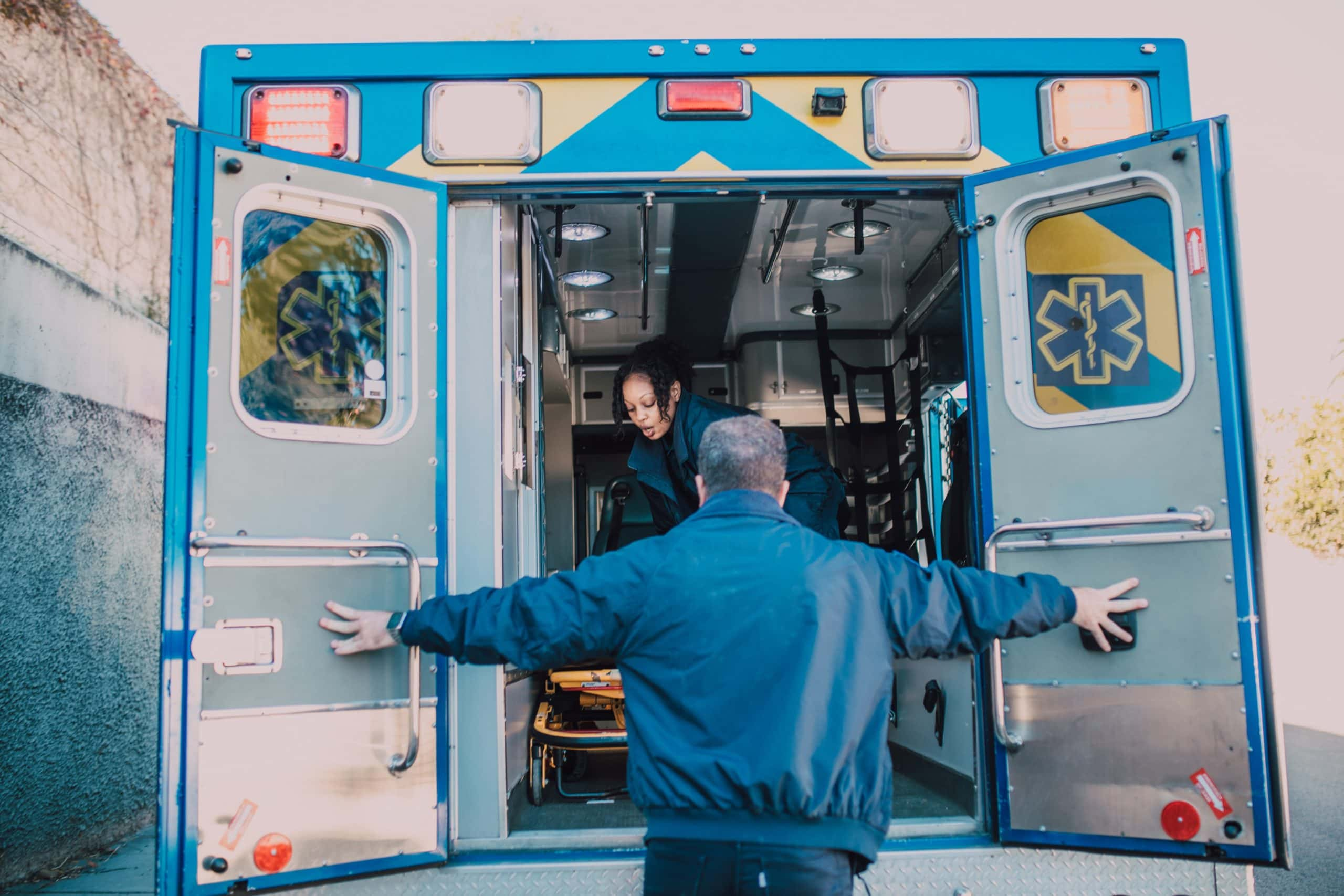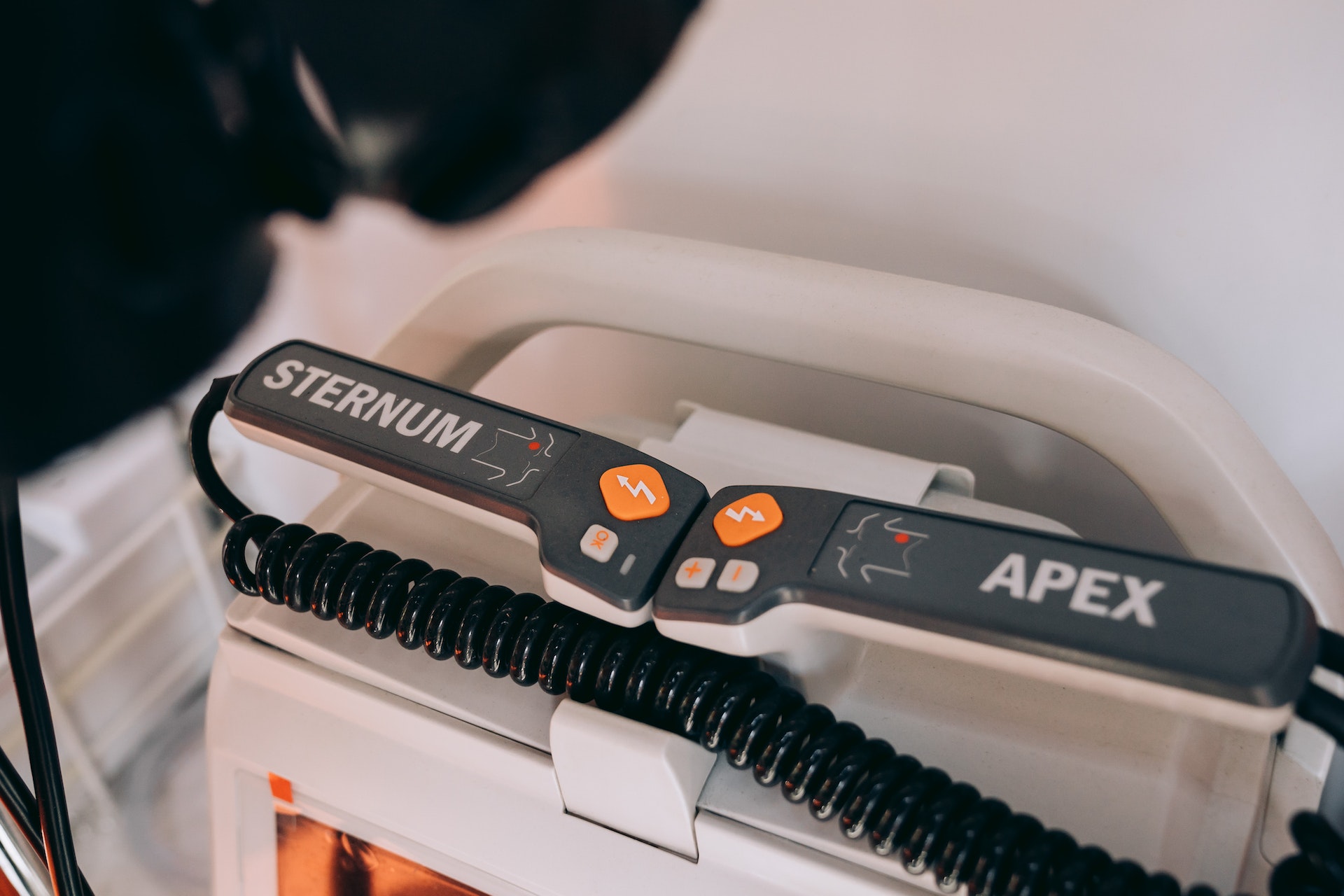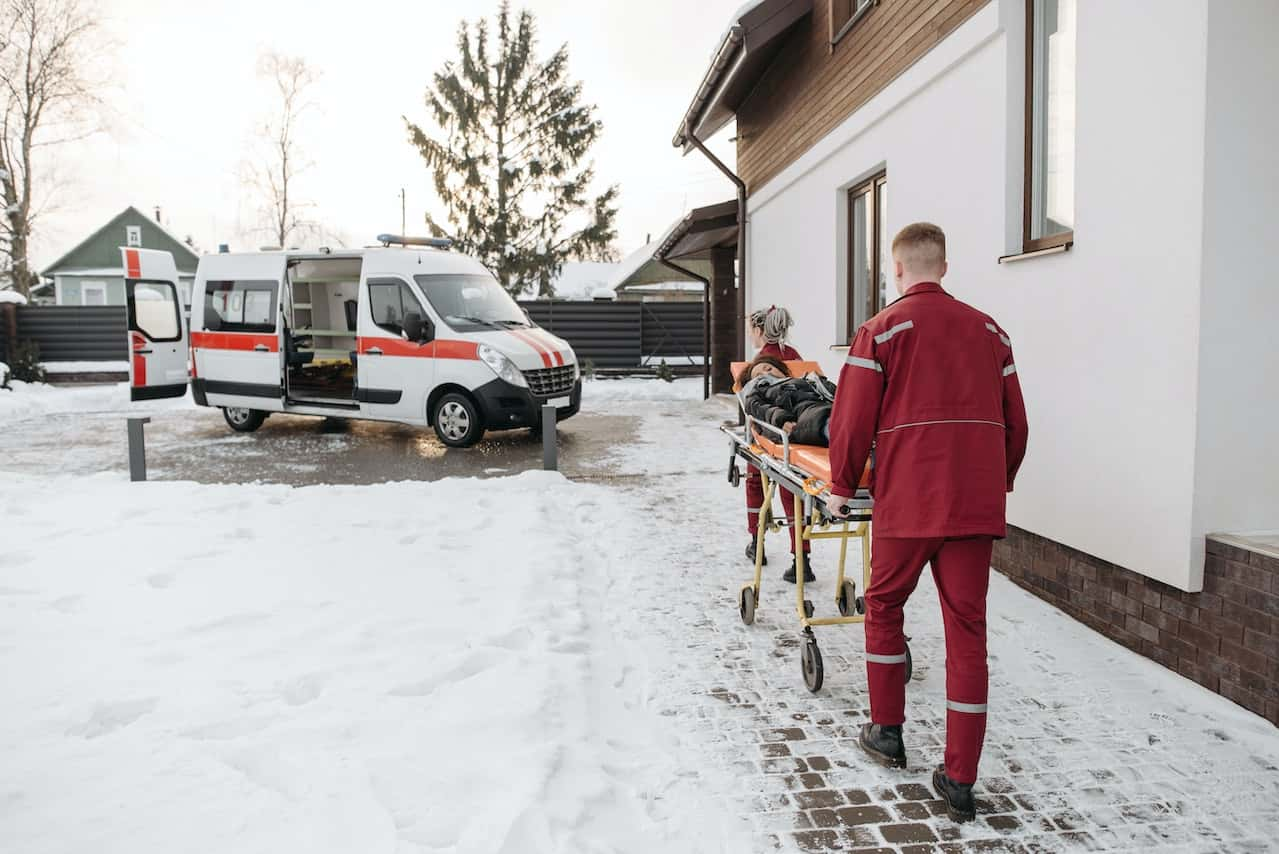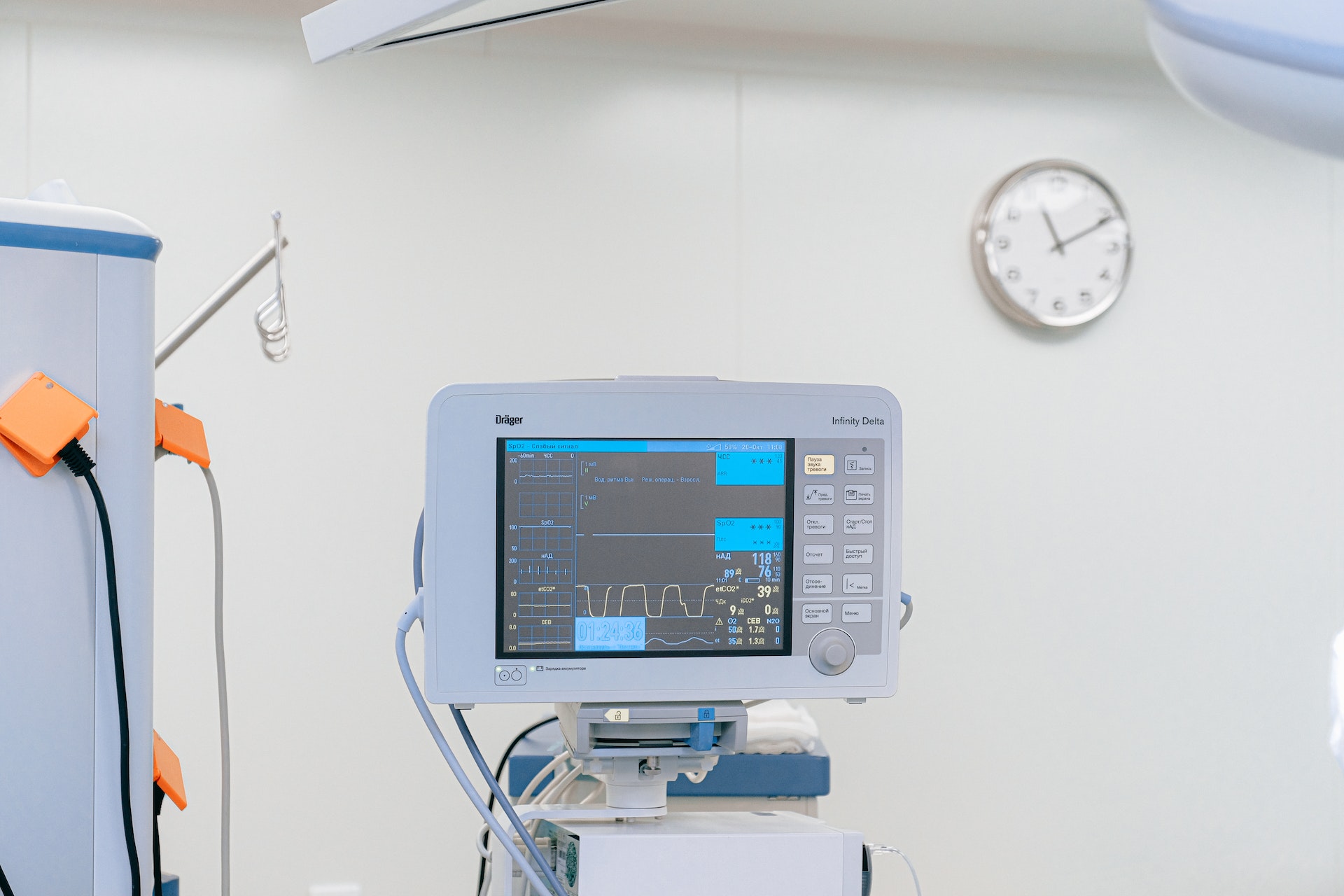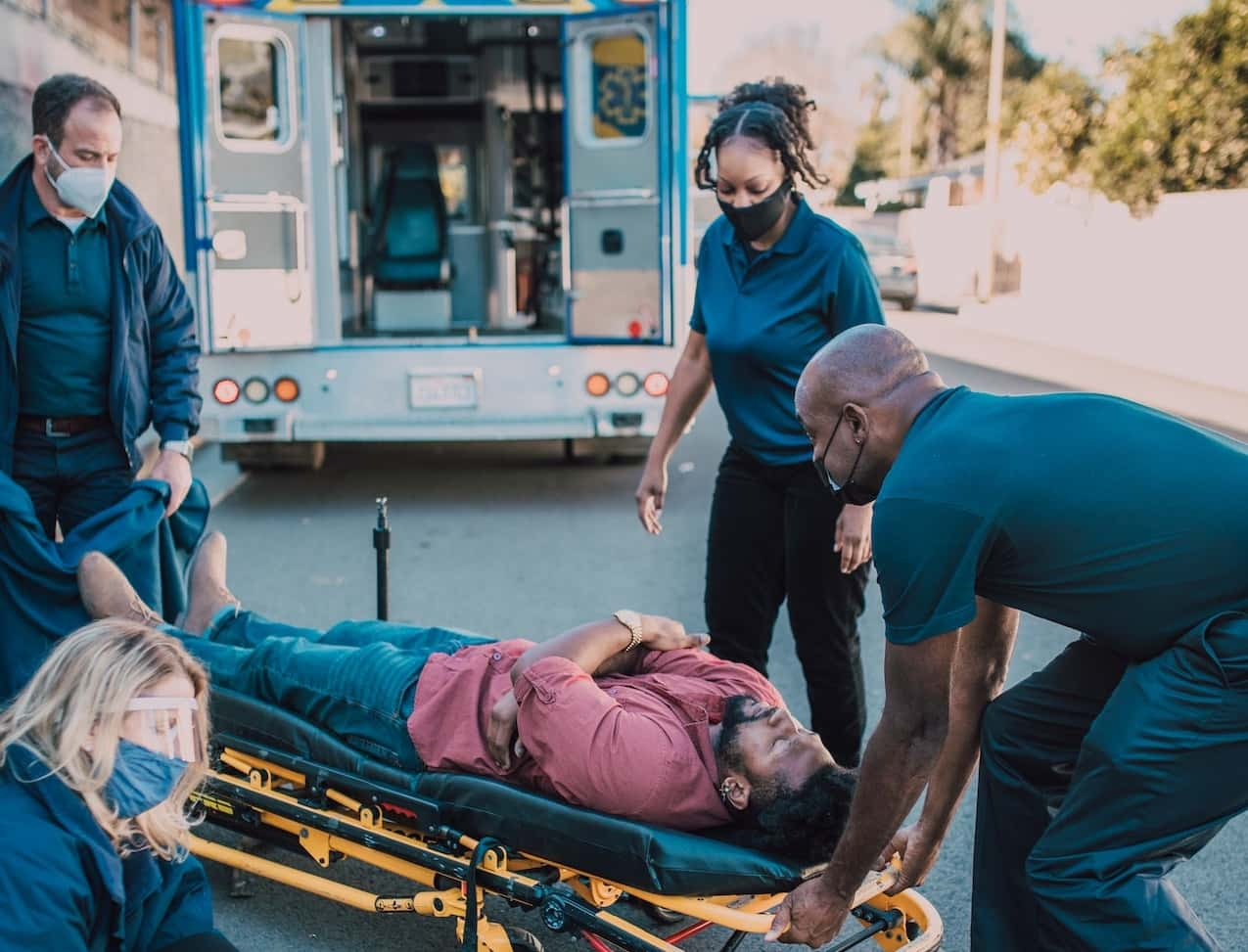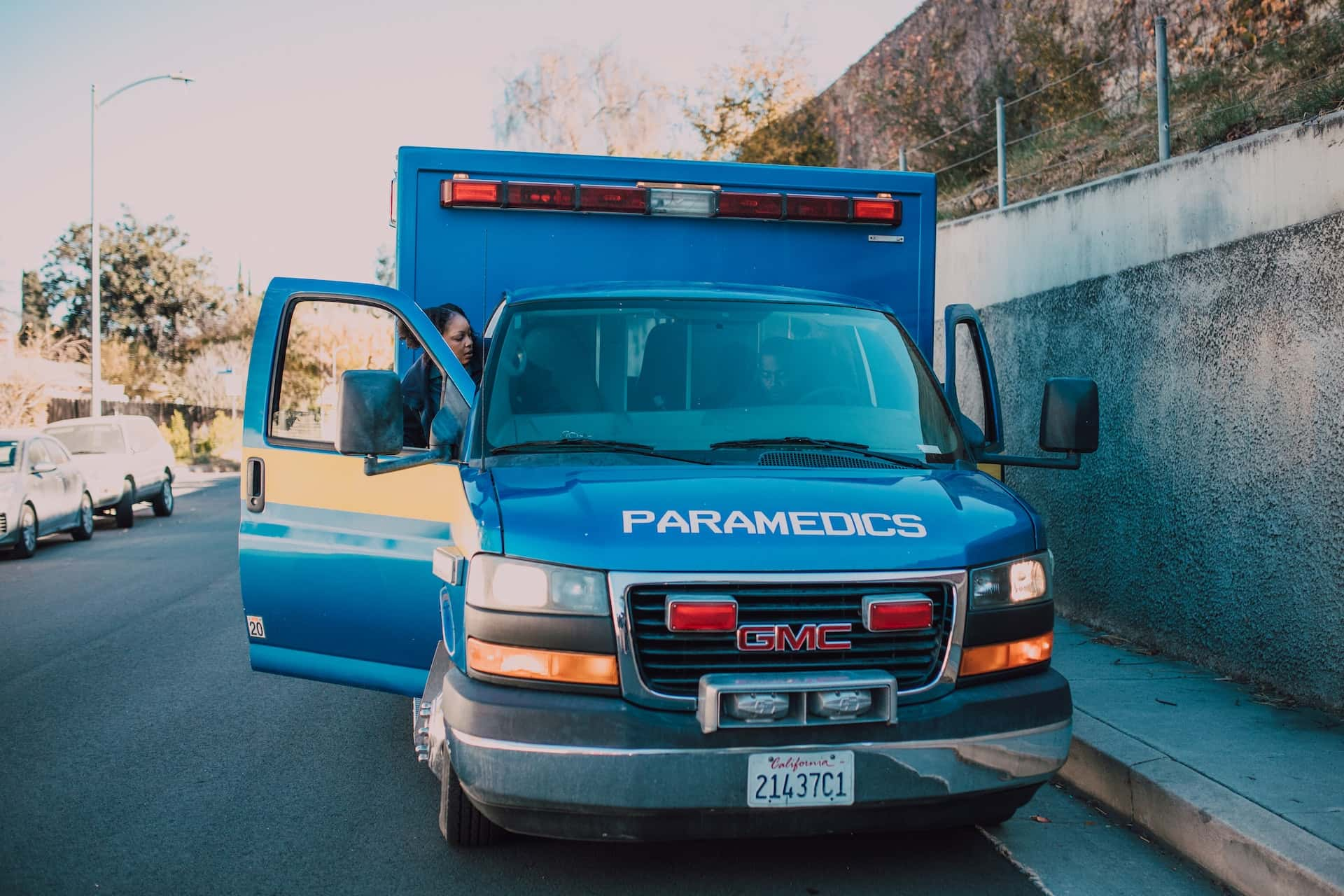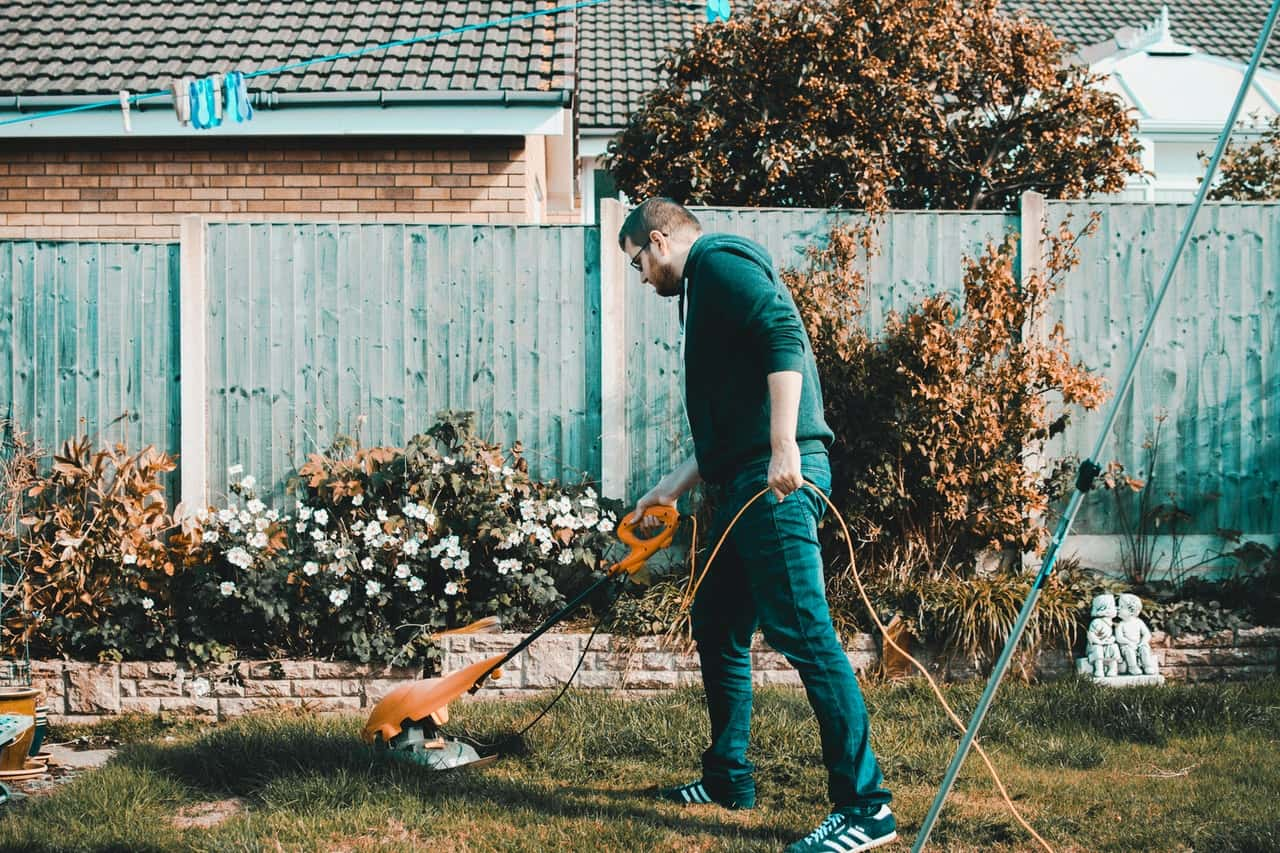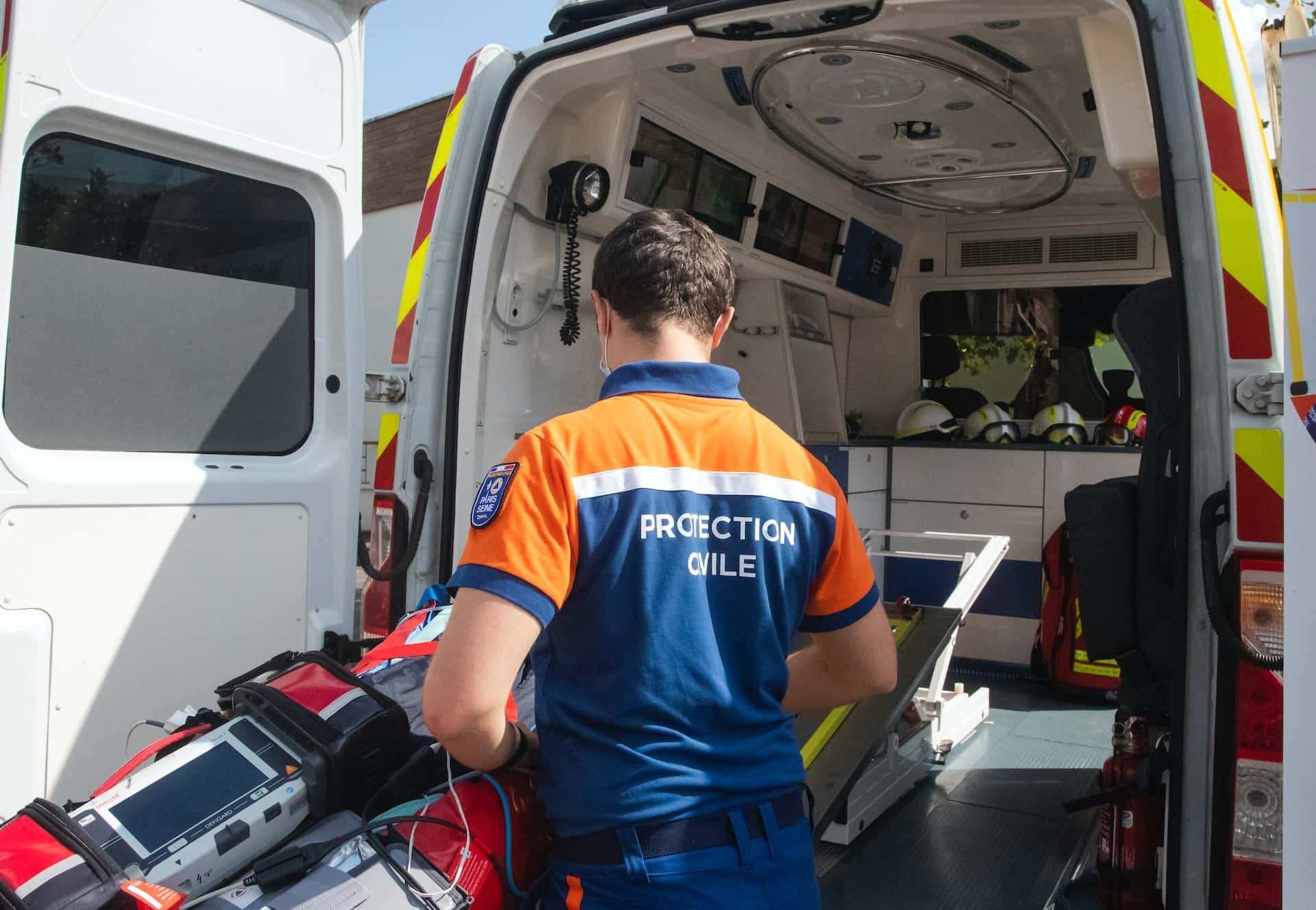Doctors and medical professionals see patients in all sorts of conditions. There are times that even they are stunned that the person in front of them is still living and breathing. These Redditors share their stores of people who should have been long gone yet weren’t. Miracles indeed happen every day.
1. What A Fall!
We were the nearest hospital, so they rushed a civilian to us. His safety equipment malfunctioned, sending him plunging 128 feet down from a communications tower. The night before had seen rain, which resulted in a soggy, marshy puddle, surrounded by tall grass where he happened to land flat on his back.
It was shocking when I first examined him. He'd sustained a concussion and severe whiplash. Astonishingly, he didn't have a single broken bone, but boy, the bruises! They painted his body from top to toe, a sight to see. He needed to stay at the hospital for a week until moving around got a bit easier for him.
2. Are You Kid-neying Me?
One of my buddies was feeling significantly run down for several days. Regardless, he went to work, but he was always wiped out afterwards. This triggered a cycle of returning home to sleep for an overwhelming 13 hours, and then doing the same thing all over again.
Things got so bad that he finally decided to visit the emergency room (ER). This decision led him to drive himself to the hospital in the wee hours of the morning, around 3 AM.
Upon arrival, his condition was so precarious that the sight of him made the security guard exclaim, "OH MY GOD", and he promptly brought over a wheelchair for my friend. The people at ER admissions expressed a similar response, and hastily fetched the ER doctor for his immediate attention.
The ER doctor observed my friends' alarming yellow appearance, so a blood test was ordered right away. The results were so shocking that the doctor had the test rerun, just to be sure. With the results from the second run also confirming the first, my friend was asked for his emergency contact details.
Still trying to keep a sense of normalcy, my friend told the doctor not to wake his mom, since it was still around 4 AM. To which, the doctor solemnly revealed, "Your kidneys have completely failed."
Accordingly, immediate action was taken. The doctor explained, "We're going to move you upstairs to give you a blood transfusion and dialysis. But we need to know who to inform if things don't look promising. You're actually lucky to be alive right now; you should have been in a very bad condition a month ago".
After that critical phase, my friend got a kidney transplant from his sister, which fortunately was a perfect match. Fortunately, this gave him a new lease on life, and he's now living a pretty much normal life, all thanks to his sister's organ donation.
3. The Sweet Life
Let me tell you about a case I handled involving my patient suffering from diabetes. Sadly, the patient was blind, and due to the same disease, they had lost some toes and part of a foot. I was aghast when I checked their glucose reading, seeing a surprising 45—way beyond the standard range of 4-7, it made me think I'd made a blunder.
I double-checked just to make sure. Surprisingly, it was 45 again. Despite the high reading, the patient wasn't showing any symptoms typically associated with hyperglycemia. Quite casually, he grabbed his insulin pen, dialed the dose, and gave himself an injection.
All I could do was wait and observe for any adverse reactions. Luckily, there was none, and he seemed totally fine. It's worth noting that usually, typical home glucose meters aren't designed to measure beyond a reading of 30.
The high reading also baffled the nurse training under me, leaving her absolutely stunned. The experience was quite out of the ordinary.
4. Everything But The Kitchen Sink
When I worked as a lab technician, there was a particular individual who came in that I humorously referred to as "Everything Guy". This person arrived home after a trip abroad with a bellyache, prompting us to ask what he had been up to. We eventually found out the shocking truth.
Turns out, he had been traveling in West Africa, where he didn't take any precautions against diseases. He didn't take any antimalarial medicine and decided against vaccination. He confessed to eating local wildlife, which he suspected might not have been cooked thoroughly.
It didn't stop there—he consumed water directly sourced from a river, sans any filtration. As it later came out, this river was heavily contaminated. While on his trip, he had encounters with sex workers and opted not to use protection. His behaviour was a perfect example of what not to do while vacationing—he covered the entire "don't-do" list.
5. Blood On Our Hands
I remember one intense case: a woman, fresh from labor, had to endure four hours of pushing then had a C-section. Once we made it back to her room, I checked her bleeding level by pressing on her tummy.
It seemed more than normal, so I alerted the doctor. After his inspection, her bleeding seemed to have lessened. Then, the blood pressure monitor gave us a concerning reading in the 60s.
On my next check, I found a continuous stream of blood clots, each about the size of a tennis ball. Thankfully, the doctor was nearby, and upon seeing her blood pressure, he promptly called for a massive blood transfusion. Returning to the operating room, we gave her substantial amounts of blood and fitted her with a tamponade balloon, before transferring her to PACU for full recovery.
It was just another nurse and myself on the team. Initially, everything seemed to be improving, but then things took a turn for the worse. She had excessive bleeding, her lips turned blue, her complexion deathly pale, and her blood pressure dropped to the 50s.
The doctor, busy elsewhere, sent his resident to check on her condition. Despite the situation, they advised just providing more blood, so I decided to call in the anesthesiologist for another opinion.
This particular anesthesiologist had a reputation for being curt, but he immediately recognized the seriousness of the situation. He swiftly summoned the OB, quite forcefully, to attend immediately. I felt newfound respect for the anesthesiologist then, grateful that he took my concerns seriously.
Ultimately, we returned to the operating room, where the woman needed an emergency hysterectomy. The doctor compared her battered uterus to a paper bag.
Coming from an ICU background, I was no stranger to dire cases, but I confess I was truly scared this woman might lose her life. She suffered tremendous blood loss—almost three liters—and was placed on a ventilator before being admitted to the ICU for several days.
I was so shaken by the whole event that I couldn't bring myself to visit her again. Being relatively new to the labor ward at the time, the incident left me questioning if I had overlooked something.
6. The Gall Of It All
The physician who examined my mom was astounded that she was still standing. A while back, my mom was dealing with some serious digestive issues. She was plagued by constant stomach pain and severe constipation.
After three days of not being able to use the bathroom, she decided to seek medical help. The doctor, after a comprehensive check-up, concluded that she needed an urgent gallbladder removal.
The day after the surgery, my mom woke up to find the doctor looking down at her, and he did not seem pleased. "Your gallbladder was [destroyed]" he started. "It was completely [gone], beyond saving. It was even gangrenous. If you had delayed by a day to come see me, you would have been [gone].
If it had burst during the procedure, you could have [lost your life]. That was the most nerve-wracking surgery I've ever done in two decades of practice. No offense, but I hope our paths don't cross again", and with that, he left the room.
7. A Change Of Protocol
About ten years ago, the sequence in the CPR process was switched from ABC (which means Airway, Breathing, Circulation), to CAB (Circulation, Airway, Breathing). What this means is that, instead of initially opening the airway and providing rescue breaths, we begin with chest compressions.
The first time I applied the updated version was during a witnessed heart attack. Luckily, I happened to be right at the patient's side when the heart rhythm changed radically, enabling me to instantly start the needed rescue measures.
The patient lost consciousness and had no detectable pulse, while the heart rhythm showed a fast and irregular heartbeat known as Ventricular Tachycardia. When I started the chest compressions, to my surprise, the patient lifted their arms and tried to punch me.
Puzzled, I paused to check the heart rhythm, pulse and their alertness level. The heart rhythm still indicated pulseless Ventricular Tachycardia, and they immediately rolled their eyes back and lost consciousness.
I guess, I started the chest compressions so promptly that the patient's brain hadn't yet experienced any oxygen shortage. This unique situation has not occurred since.
8. MRSA Almost Did Me In
A while back, I headed to the ER to have a cyst removed. Fast forward three weeks, I started experiencing back pain. Another trip to the ER resulted in nothing but an X-ray and no clear diagnosis. I felt drained as I left the ER and I decided to head home and rest on my couch. When I eventually woke up, I tried to stand but quickly fell down, which in turn led me to call an ambulance for help.
After waiting for what felt like an eternity—six hours to be exact, a medical professional finally attended to me. They were instantly alarmed—I had spiked a fever of 105°F. Without wasting time, they conducted an MRI which shockingly revealed MRSA infection in my spine.
I was promptly rushed into surgery, and now I am making use of a wheelchair for mobility. The fusions happened from T5 to T11 on my spine. The doctors expressed how lucky I was—apparently, had I delayed by just one more day, things could have been much worse.
To successfully combat the infection, I had to endure 16 weeks of Vancomycin treatment via IV for three grueling hours, twice each day. There's no doubt that I'm incredibly fortunate to be alive today.
9. Too Cold For Comfort
I once treated a patient whose body temperature was a shocking 75°F. He was fairly groggy, but surprisingly still alert and coherent. We discovered him on a river bank in the chill of winter, where he'd spent the night before being spotted by someone walking their dog.
Honestly, we couldn't quite trust our equipment when it read out 75 degrees, so we decided to double-check. We used a different rectal thermometer and even a probe connected to the bed and a medi-therm system—they all agreed.
After hours of diligently applying heat, we managed to raise his body temperature to a still-low but more stable 90 degrees, at which point he was transferred to intensive care.

History's most fascinating stories and darkest secrets, delivered to your inbox daily.
10. Eat Up!
My son's first encounter with the outside world was an unusual one. When he was just a day old, the nurse carried out a routine check on him. However, she couldn't record a temperature reading. Unsettled, she switched to a modern digital thermometer but to no avail. Next, she moved him under a heat lamp.
After a while, she finally got a temperature reading. However, the lack of initial reading was an alarming sign. A blood sugar test was done, revealing an astonishingly low level.
Fear gripped everyone in the room as my son was moved to the Neonatal Intensive Care Unit (NICU). He stayed there for the next two weeks. They found out he was suffering from a genetic disorder known as MCAD.
The disorder makes it impossible for his body to metabolize medium-chain fats, which implies fasting can literally be life-threatening for him. His body relies on sugar reserves, but once these deplete, he could lapse into a diabetic coma. That's exactly what happened just moments after his birth.
In those early days, he didn't want to breastfeed or take a bottle. Thus, we faced a harsh introduction to his condition. For 18 grueling months, he had to eat every few hours, depriving my wife and I of any chance of a full night's sleep up until he was five years old.
Whenever he came down with the flu and couldn't keep anything in his stomach, we ended up in the hospital for him to receive a sugar drip. But, resembling a victory story, he's now an 11-year-old, 5'8" and 155-pound sturdy boy with no trace of any long-term effects from his birth complications.
His MCAD condition hasn't re-emerged, though we ensure he gets enough calories daily. Looking ahead, my only worry is when he becomes a teenager or a young adult. Whilemost can handle fasting during a hangover, he can't take that risk.
11. Snaking Along
Once, we had a patient who got bit not once, but TWICE by a rattlesnake. It took him three hours to even make it to the emergency room after the bites. And then, if you can believe it, we had to wait another hour after he came in before we could get the right antivenom delivered. But hold on, the story has a happy ending—that guy is now fit as a fiddle and works right here at our hospital as an administrative clerk.
12. Holding On For Dear Life
On my emergency medicine shift, a man was brought in after a car crash. His body bore the brunt of the accident, with deep cuts exposing his intestines, almost half his face scrapped away, an eye dislodged from its socket, and muscles from his right forearm torn to reveal the underlying bone.
Wwhen I arrived, there was a glimmer of hope—his bleeding had already ceased. I noticed his chest rising and falling, and saw him clutching his intestines. My immediate reaction was surprise and relief that he was indeed alive. We quickly attended to his needs, stitching up his wounds and reconstructing his face. Today, he's not only alive, but he's also doing well.
13. Against All Odds
My job is in public health, and there have been instances where I've had to keep tabs on some patients whose survival was beyond my understanding. I once dealt with someone with a host of health problems—a set of hepatitis A, B and C, endocarditis, a damaged mitral valve, AIDS, abscesses, and MRSA in their bloodstream.
I had to take full precautions just entering their room by covering up with a mask, gloves and full protective gear. Early on, it became evident that this person couldn't really engage in any conversation.
After a while, I learned that they were transferred to another hospital to undergo open heart surgery after they tried, believe it or not, to leave the hospital despite the doctor's advice (AMA). Following the surgery at the new hospital, they began to recover a bit. Astonishingly, their parents signed them out also AMA for the several hours long journey back home.
I was utterly astonished. It was beyond me how they could even manage to get home safely. Yet, incredibly, their name popped up in another public health study a year later, showing they were still alive. Their survival after all they'd been through left me absolutely stunned.
14. Eternal Slumber
As a sleep technician, I once had a patient in their mid-life years who experienced a significant drop in their oxygen levels, dipping into the 40s. Interestingly, this patient also had central apneas, which meant they stopped breathing for periods extending beyond a minute while asleep.
Notably, their sleep was marked more by these periods of non-breathing than actual restful sleep. No surprise then that they constantly expressed a feeling of not really being fully alive each day. I found the situation so hard to grasp that I decided to use multiple oximeters, testing various hands and fingers. Yet all readings pointed towards extremely low oxygen when the patient slept.
15. Preemies Pulling Through
I've spent my career working with newborns, particularly in the preemie unit. In my experience, some of these extremely premature babies appear very fragile, their small heads are only about two inches from chin to top, with skin so delicate and thin it could almost be described as translucent in a reddish-purple hue. Their eyes remain shut, they show no signs of responsiveness, and their tiny limbs are even smaller than a finger. They're usually very thin, too.
These babies often have to deal with lifelong complications as a result of their premature birth. I once questioned a doctor about why we continue to fight for these little ones when the situation sometimes seems so dire. The doctor's response always stayed with me. She explained, "The preemies that were once seen as lost causes 20 years ago are now leading normal lives. That's why we never stop trying."
16. My Life Almost Went Down The Toilet
I had a health scare that took me by surprise. I noticed some blood after using the bathroom that was more than I thought was normal. I went to the doctor, who examined my backside and told me I had irritated some hemorrhoids. He suggested I try baby wipes and use Preparation H. Two days later, I felt awful with a terrible headache.
That morning, I woke up just in time to go to work. I felt too sick to go in but went anyway—a decision that nearly cost my life. About halfway through my day, I passed out in the bathroom, and a coworker eventually found me. The paramedics rushed me to the hospital, noting that my oxygen levels were dangerously low.
As soon as we arrived, they hurried me into a room, urgently telling me I needed a blood transfusion. After I passed out again, I woke up to a nurse yelling about why I hadn't been hooked up to the blood supply yet. It seemed that there had been a mix-up between determining my blood type and delivering the blood. I waited in critical condition for nearly 50 minutes, which made the nurse who found me really upset.
Finally, the transfusion began, and I received three pints of blood initially, followed by another pint the next afternoon. They detected the hemorrhage and carried out a minor surgery. Thankfully, I've been healthy since then. The same nurse came to visit me post-surgery and told me how worried she was when reviewing my vitals during the handover from the EMTs.
17. A Stroke Of Luck
A young lady in her 30s suffered a stroke. It caused a blockage in the basilar artery, a major blood vessel located at the base of her brain, responsible for essential functions like breathing and consciousness. I learned about her condition a day following the incident. Conventionally, her situation seemed utterly hopeless. It was as if she was already gone. However, due to her young age, they persuaded me to make an attempt.
I inserted a catheter into an artery in her groin and carefully guided it up to the blocked artery at the base of her brain. I then used this to deliver clot-dissolving medication (tPA) directly into the artery for roughly 12 hours. Afterward, I checked and happily found the clot had disappeared. The next day, she was awake. Incredibly, after about a month, she walked out of the hospital on her own. It was the most amazing recovery I've ever witnessed.
A month or so later, she sent me a beautiful card. Strangely enough, it irked me that her handwriting was neater than mine, even post-stroke. However, I was overwhelmingly pleased.
18. Glop In His Gams
My father suffers from a blood disorder which increases his risk of developing clots. This health issue has landed him in the hospital multiple times. Here's what happened during his most recent incident. He had initiated a daily night run routine to raise funds for a non-profit organization. Each time he returned from his run, we noticed he seemed unusually out of breath and complained about intense leg pain. Initially, he brushed it off as mere muscle cramps. However, after seeing his discomfort, mom finally suggested he see a doctor.
Upon hearing the symptoms, the doctor advised him to head straight to the hospital. The hospital staff ran an MRI scan, and a nurse informed us of the shocking discovery. The nurse explained, "This is the largest blood clot we've ever seen in someone who is still alive."
19. Marfan’s Maimed Him
I used to be a heart technician, while also working as a radiology specialist. One day, a healthy young man in his 20s passed out in our critical care unit while visiting his friend. He had lost all pulse in his thigh area and was suddenly in a really bad condition. We were requested to carry out an aortic angiogram on him to understand the structure of his arteries, but all his access points were blocked.
Eventually, we managed to insert a catheter into the artery in his left upper arm and we got a clear view of a total aortic dissection. This means that from his heart valve, down to his thigh arteries, the inner layer of his main artery had a tear, affecting his kidney and most blood vessels below his stomach. We worked tirelessly to stabilize him as much as possible, and then had to send him off to Houston where he underwent grafting surgery and miraculously lived.
I bumped into him around two years later when he came to our hospital for a routine checkup. His body was ridden with surgical scars from his neck down to his knees; there was a lot of plastic surgery work done! Apparently, he had undiagnosed Marfan syndrome, which is a genetic disorder that affects the body's connective tissue that nearly cost him his life. Up until then, I wasn't really familiar with Marfan syndrome, but now, whenever I notice unusually long and thin fingers, my mind immediately goes back to that brave man.
20. Black Market Bacteria
A young woman, aged 23, was brought in struggling with sepsis following an unsanctioned kidney transplant. She was on the waiting list for a legitimate transplant, but without any matches coming up, her parents took drastic measures. They didn't disclose the location where they got the kidney. Unluckily, she was harboring a bacterial infection known as New Delhi metallo-beta lactamase (NDM).
Let me explain why this is really, really bad—this particular bacteria makes an enzyme called carbapenemase. This enzyme can 'eat up' a wide variety of β-lactam antibiotics, including carbapenems—these are our go-to antibiotics when dealing with persistent, resistant bacterial strains.
In essence, despite us administering the best antibiotics we have, this resilient bacteria was effectively neutralizing them. The young woman subsequently contracted a secondary infection from pseudomonas bacteria in both her eyes, which made removal of her eyes necessary.
Pseudomonas bacteria is particularly unpleasant and it's something you definitely don't want in your eyes.
21. Padded Bliss
A young woman, likely in her early 20s and weighing about 400 lbs, was involved in a rapid-speed car crash. The accident ripped her vehicle apart, and she was thrown roughly 100 feet away, landing against a telephone pole.
When first responders arrived, they initially assumed she hadn't survived, but surprisingly, she had. Despite the accident looking severe, her considerable body fat had guarded her from severe damage. She sustained a few broken bones but was otherwise unharmed.
22. Gut-Wrenching Accident
During my time in surgery, I was in my trauma rotation as a resident. We received a pleasant young man who was brought in by emergency medical services. He'd been working high off the ground at a factory, descending a tower when there was a sudden uproar from above and someone began shouting a warning. However, he had no chance to respond.
The back of his neck was struck by something. Despite this, he remained calm, touched the back of his neck, and discovered a sizable chunk of metal lodged into it. His medical training instincts kicked in.
He calmly completed his descent, sat himself down, and instructed someone to dial for an ambulance. The lodged item was a 14-inch wrench, with one end fashioned into a sharp, pick-ax like tool.
This was what was stuck in him, snugged against the middle of his neck, also known as the C3/C4 area. We could only perform X-rays due to the large amount of metallic distortion interfering with a proper CT scan.
Luckily, no fractures were visible. His neurological examination was completely unremarkable. A superb spinal surgeon took the bold move to simply remove it. The patient was stitched up, had a soft neck brace for a week, and then he was back to his usual health.
23. Back Again
When I was 18, I got my first motorcycle. As I was leaving the dealership, an unexpected accident happened: a sleeping driver crashed through the highway barrier, came onto the service road where I was, and hit me. I somehow made it through that without suffering fatal injuries.
A month later, I got my second motorcycle. But, unfortunately, trouble found me again. This time, at a traffic light, a drunk driver rear-ended me.
And as if two accidents weren't enough for a year, there was one more incident waiting for me. I was rappelling and a poorly set anchor slipped loose, adding more rope to my line which then jolted my back. I ended up in the hospital again with the same doctor. He was shocked to see me unscathed again and asked, bewildered, "How on earth are you still alive, and why are you back?"
24. Back From Beyond
On a sweltering summer day, a person suffered from heart failure. He was discovered unconscious, with no one knowing for how long. A passerby started doing CPR, and when the paramedics arrived, they took over, performing CPR for almost half an hour. Finally, after 30 minutes, a miracle happened—they found a heartbeat. The person was rushed to the emergency room and later, taken to the ICU. Once his condition appeared a bit stable, he was moved to our ward.
The person was in a vegetative state, unable to move or respond. Despite his condition, his family didn't want to give up hope. For a whole of eight weeks, he remained unresponsive until one day, he miraculously woke up. We found him on the floor, attempting to crawl out of the room, removing his tracheostomy tube and various medical lines. He was thoroughly disoriented, and trying to guide him was a challenge. The reality was sad, but very clear—he had sustained significant brain damage.
Fast forward five weeks—he was ready for discharge, fully mentally competent and acing all cognitive examinations. He vividly remembered everything that happened before his heart episode. He said he was given a second chance at life, and he wasn't about to squander it. I'll always remember that patient.
25. She Was A Heartbeat Away From Death
I'm employed in the healthcare sector and my job involves capturing ultrasound images of human hearts. Once upon a time, I was examining a woman, who appeared to be middle-aged, in the ER. I was about to restart my ultrasound device because it seemed to be "stuck". Believe it or not, it wasn't the machine; her heart was hardly pumping, giving me the illusion that it wasn't moving at all. This woman, who had just walked in from the street, was feeling breathless.
Normally, a heart's ejection fraction or its ability to squeeze effectively is 55% or over. But in her case, it was barely 2%, if even that.
Due to its sluggish pumping, blood wasn't circulating properly and this resulted in clots. One such clot was enormous. It measured a good 6 cm x 5 cm. To provide a comparison, a woman's heart, when found to be dilated, measures 5.3 cm. So, the clot was larger than an enlarged heart. That was a seriously dangerous situation. I'm still amazed how she was able to function, let alone walk around, with such a condition.
26. Low And Behold, She Was Walking
During my tenure as a laboratory technician in a Connecticut hospital, we once received a patient who reported experiencing fatigue and unsteady balance. The physician on duty requisitioned a Complete Blood Count, or CBC, to diagnose her condition.
However, when performing the CBC, our machine encountered difficulties in assessing her hemoglobin levels due to their critically low value. Consequentially, we switched to employing our blood gas analyzer for obtaining the required information. Surprisingly, the result came out to be 2.8.
Normally, at such low levels, the patient would have lost consciousness, but incredibly, she hadn't. She had managed to come to the hospital all by herself.
27. Getting Buzzed For The Buzz
We once had a patient who struggled with chronic PSVT, which is a type of rapid heart rate. Eventually, he'd slip into VT, a dangerously fast and irregular heart rhythm that's fatal if not quickly treated. This essentially means his heart rhythm was consistently out of sync, leaving him in need of defibrillation, an electrical shock therapy, to revive him back to a stable rhythm. If left untreated even for a moment or two, he could risk his life.
He proved to be resistant to a therapeutic process labeled chemical conversion, which involves using medicine, administered intravenously, to restart the heart. Therefore, he absolutely needed defibrillation. VT is an inefficient heart rhythm that doesn't sustain life, whereas PSVT and SVT are more like early warning signs. If these are ignored for too long, your heart throws in the towel, rounds off its rhythm with a VT spell, and you're out of time.
Keep in mind, defibrillation is painful. If you are conscious, it's an unpleasant experience. As a precaution, we usually administer sedative drugs (benzos, also known as Versed) prior to shock therapy. Our patient, however, was facing another complication.
He misused substances and often neglected the medications required to regulate his heart rhythm, deliberately attracting emergency cases. In those critical moments, there was hardly time for debate regarding drug administration, it was crucial to defibrillate him to prevent slipping into a fatal VT rhythm.
For the first few instances, he was given Versed. But soon, the doctors wised up to his antics, and began the defibrillation without prior sedation. He would recklessly toy with his own heart's rhythm to experience a temporary high, having done it so often, it's baffling he survived. How he knew when to end up in ER, or how he managed to stay on the edge of danger without completely tipping over is puzzling.
Over the span of a few months, his actions led to him having a pacemaker implanted. The pills he was prescribed effectively slowed his heart rate or maintained a stable rhythm post-defibrillation. All this could have been avoided had he simply stayed adherent to his medication. The pacemaker was installed as a preventive measure to stop him from exploiting his condition to access intravenous medications.
Think of defibrillation as more than just a heart jumpstart. It's akin to a bout of intense electric shock, reseting the heart's rhythm entirely. The patient was essentially playing Russian roulette with his own life, and any instance could have cost him dearly.
28. Back With A Vengence
A year ago, I had a severe osteomyelitis infection in my foot. I went through a gruelling 89-day course of outpatient IV Vancomycin to treat MRSA. Despite the intensity of this treatment, I just couldn't face the fact that the infection might have made a comeback.
The doctors had warned me about this possibility because of the dead tissue in my bone. I was constantly tired, sleeping nearly 20 hours a day and couldn't do much else—and things only got worse.
It reached a point where my wife desperately threatened to leave if I didn’t get myself back to the hospital. So, I braved the rain, rode my bike back to the outpatient clinic, and checked myself in through the ER. The first alarm bell went off when my pulse oximeter reading showed 68; normal readings rarely dip below 90.
Then my blood pressure dropped sharply to 78/42. In no time, I was whizzed off by ambulance to a large hospital where I was diagnosed as being septic and in the early stages of organ failure. My memories of this time are hazy but I remember a very kind ER nurse. Two weeks later, I woke up to a shock—I no longer had a right leg.
A few days later, a nurse visited and shared that I was the most polite patient she'd ever seen in such a dire situation. She was glad to see me recovering.
29. He Just Scraped By
In residency, I encountered an incredibly peculiar patient. I received a message about an individual who had a bullet wound smack dab in the middle of his forehead. Shockingly though, he was conscious and only griping about a headache.
According to emergency responders on the scene, the incident was seen by onlookers, with the man being shot from a distance of approximately ten feet. When the man arrived, his forehead had a pit, a hole from where the bullet exited at the back of his head and an unusually sensitive bump on his scalp. It was quite the spectacle.
Besides some discomfort, he proclaimed he was alright. After conducting a CT scan, it was evident that the bullet had essentially skirted around his skull and the damage was only skin-deep. Strangely enough, it felt odd to release a patient who'd sustained a gunshot wound to the head, back home from the ER.
30. A Long Road To The End
I used to be a nursing student and worked as a nurse's aide at a hospital. There was a patient who was admitted because of a blood clot in her leg. This happened because she overdosed on drugs, fell unconscious, and her leg got pinned under her. She remained in that position for nearly two days before being found, by some miracle still alive. Her leg clot was due to it being trapped under her body for so long.
She stayed as our patient for close to six months. Usually, patients are with us just about a week or so. During her prolonged stay, her weight dropped drastically because she wouldn’t eat. Her hair got so tangled we had to chop it off after several unsuccessful detangling efforts. Standing at 5’6”, her weight plunged to 90 pounds.
Most of the time, she declined her physical therapy. It seemed like she didn't want to improve. She was also good at manipulating the medical team; demanding painkillers, but refusing simple things like having her vital signs checked. Physical therapists would daily persuade her to get moving, and on rare occasions, they would succeed in getting her up.
Eventually, she grew strong enough to walk with a walker, her clot had been taken care of, and we discharged her to a downtown shelter. In less than a day, she ended up in the ER of another hospital, and they referred her back to us. She continued her familiar pattern of refusing care and not eating for another eight months. When she eventually passed away, she weighed just 68 pounds due to self-starvation.
She declined feeding tubes and pretty much any other medical intervention suggested. I doubt she would've survived as long as she did if it wasn't for the IV fluids. Despite numerous sessions with a mental health professional, she refused their assistance too. It was as if she'd already left us from the moment she was admitted. It shocked me that she essentially lived at our hospital for more than a year before she eventually passed away.
31. She Must’ve Had Nerves Of Steel
My cousin, a practicing doctor back in our home country, relayed a remarkable incident involving an expectant mother. The woman had been brought into their hospital after a shocking accident where a steel rod fell from a construction site and impaled her stomach while she and her husband were motorcycling at a usual speed. She arrived at the hospital with the rod still jutting out from her, a terrifying sight to behold.
In a swift rescue operation, they had to cut the rod away and proceed straight to delivering the baby. Thankfully, her vital organs had escaped harm, and due to the baby being aptly positioned within her at that precise moment, the infant survived. So, despite the scare, the baby was born safe and sound.
32. Saved By A Sliver
One of our regulars paid us a visit in the ER that evening. This fella, about 50-years-old, was known for his drinking problem and often getting into trouble with his buddies and acquaintances.
His repeat visits to the ER usually resulted from altercations, accidents, or some foolish act. This time, he ended up in the ER because of a disagreement over money with a so-called "friend."
This time, things were different—things spiraled downhill real quick. He was always hard up for cash, so the situation escalated into a fight. He was pushed down, and then the "friend" stepped on his throat and whacked him on the side of the head with a crowbar before leaving him bruised and bleeding on a cold, concrete floor.
An onlooker called the ambulance, and he was brought in. Despite his condition, he was able to walk and talk sensibly. He just wanted to have a smoke, munch on some snacks, and couldn't really grasp why he was brought into the ER.
After all, he didn't seem to be in pain and only appeared to have some minor swelling, fully functional eyesight, too. But we chose to perform an X-ray just to be sure, and I helped him get onto the X-ray table. He insisted on doing it himself, but we wouldn't let him risk it. The X-ray results were grisly—his skull had been breached by the impact, splintered into small fragments, and a critical blood vessel had been ripped open.
Fortuitously, he was saved by a one-in-a-million shot: a tiny piece of skull bone had fallen into the open blood vessel, acting as a makeshift plug. If it weren't for that miracle, he wouldn't have survived long enough for help to even arrive. He was rushed to the intensive care unit immediately, and two days later, he came back in to buy some snacks, fully recovered from his ordeal. This lucky guy narrowly escaped death, all thanks to a stroke of good fortune.
33. Everything Was NOT Fine
At the age of 30, I experienced not one, but two incidents of ventricular fibrillation before doctors determined the issue and installed a defibrillator in my chest. After my first episode, they hooked me up to an ECG and believed the machine was malfunctioning due to my abnormal heart rhythms. They caught the second episode using an internal monitoring device.
When the data from this device was downloaded and analyzed the next day, the technician suspected his machine was broken. Suddenly, he went pale, trying to reassure me with, "Don't worry, everything is fine."
But he immediately rushed out to consult with the cardiologist, as I yelled after him, "It doesn't seem like everything is fine!" Within the next hour, I found myself undergoing an operation to have a defibrillator implanted. Since then, I've had three more procedures known as ablations, and I'm still here, alive and kicking!
34. Sick To Her Stomach
Back when my spouse was a medical student, she was involved with a teenage patient's case during her family practice training. The young girl had been experiencing terrible aches for about ten days. Her parents, normally attentive, dismissed her discomfort, even though she wasn't one to fuss over nothing.
My wife suspected appendicitis, but her supervising doctor dismissed it, implying that the duration of the symptoms was too long for such a diagnosis.
Persisting in her conviction, my wife managed to persuade her senior to arrange for some scans. The results showed the young patient had been living with a burst appendix for more than a week. Her abdominal cavity was riddled with infection, and there were clots forming in her arteries.
Despite these alarming findings, the parents hesitated to bring her to the emergency room. Eventually, though, they agreed and took her to the ER.
35. Waiting Game
The first time I encountered a patient with what seemed like a pulseless ventricular tachycardia, it's likely they actually did have a pulse, it was just extremely weak and beyond our ability to detect. The patient was conscious with no complaints apart from a feeling of coldness. His skin was as pale as I'd ever seen on a person, and he remained in this state for two hours before a cardiologist arrived.
We had to use cardioversion a few times—a process not dissimilar to defibrillation but with certain specific conditions. However, we had to be cautious not to sedate him excessively with Ativan; it was better for him to stay awake. We all stayed close, restlessly anticipating him to eventually lose consciousness so we could commence CPR, but he never did. Quite simply, he relaxed, watched Wheel of Fortune and waited for the inevitable.
36. Totally Blocked Out
My dad had been undertaking lots of heart tests because he'd been experiencing some issues. The physician showed him the findings, a sketch of his heart and the primary arteries, together with the level of blockage in each.
The least obstructed one was 90% blocked, while the most obstructed one was 100% blocked. His doctor made a surprising comment: "Honestly, I'm surprised you're even here conversing with me".
Next up was quintuple bypass surgery. Fast forward two years later, he's still here and even got to see his first grandchild. We hold on to a copy of his test results as a memento.
37. My Numbers Were Off The Charts
Around 2013, I weighed a staggering 466 pounds, suffered from severe diabetes, and was just 29 years old. I was living a solitude life by choice—no job, no friends, no vibrant life to speak of, all thanks to my addiction to World of Warcraft. Fast forward to 2019, after years of consistently shedding weight, I found myself in the 230s. Despite this progress, I began to experience pain in my private parts without a clear reason.
One night, I woke up to a bolt of pain shooting through my private area. I consulted a doctor who, suspecting some kind of infectious disease, advised me to get blood tests done. Later at 4:30 AM, in spite of my activated "do not disturb" mode, my phone started ringing.
The doctor on the other side informed me that my blood test results were off the charts—a critical red flag indicating a major health issue, typically cancer. In a healthy person, or even in a well-managed type 2 diabetic, blood glucose levels should ideally fall between 1-5 or 4-7.9, respectively, depending on the Endocrinologist you're consulting with.
If it scores between 8-12.9, it's high and you need to hydrate, while a score of 13-19.9 means you need immediate medical attention. Anything above 20 typically causes severe debilitation, up to and including loss of consciousness and motor function. On the day of my diagnosis, my glucose level measured a shocking 44 around 9:30 AM, even though I hadn't eaten or drunk anything that day.
The doctor urgently instructed me to hang up and call an ambulance, rather than drive myself or ask a family member to do so. Against advice, I drove myself to the hospital the next morning, around 5AM. Again, my blood test revealed an alarmingly high glucose figure of 48. After three separate draws as well as three bags of IV fluids, my blood glucose stubbornly remained dangerously high.
However, if I fast-forward to just last month, I've drastically improved. I now weigh around 160 lbs, and my average A1C is at a well-controlled 7, thanks to medication and good management.
38. A Cocktail Of Conditions
When I was 25, I found myself ill and housebound for a fortnight. In that period, I made three trips to the emergency room. This happened just before COVID hit Texas hard, leading the doctors to suspect it might be related.
Apart from diagnosing me with strep throat, they didn't provide any additional treatment. The antibiotic they prescribed proved ineffective. I suffered from recurring high fevers that wouldn't subside.
On my third visit to the ER, I checked in at the COVID station. With a high fever of 104°F and oxygen level at 79% (normal levels are above 94%), I was transferred to a different emergency unit that could provide more intensive care.
It turned out I was in a septic condition, suffering from complications due to parainfluenza, M. pneumonia, strep throat, and Rocky Mountain spotted fever. My condition was so severe, it triggered multiple organ failure, particularly impacting my kidneys.
Shortly after being put on a ventilator in the ER, my heart began to fail. I managed to survive this dire condition thanks to dialysis treatment, and woke up in the intensive care unit a few days later with no memory of the ordeal.
Interestingly, a year later, I, as a registered nurse, ended up working in that same ICU. My colleagues would tell me they thought I wouldn't make it through my health crisis alive.
39. Everything But His Brain Was A Bust
One time, I treated a patient who had been tragically injured, severely damaging his upper facial area, specifically everything under the brain—known as the suborbital structures. Most of his eyes were damaged beyond repair, with fragments dropping down towards his mouth area.
Apart from this, he also had numerous heavily damaged muscles, ligaments, and blood vessels hanging from the upper jaw bone, known as the maxilla.
To help him breathe, we inserted the breathing tube straight into the remains of his voice box, the larynx. The air could be seen forming bubbles as it filtered through the pooling blood. Later, we were able to perform a specific surgery, a tracheostomy, to establish a more secure airway.
Given his injuries, it was hard to gauge his condition—he was frantically moving about, his breath fast-paced, but with his voice box so damaged, he wasn't able to make any sound. I’m not certain, but his health situation seemed grim, leading to the likelihood of him eventually passing away.
40. This Patient Bowel-ed Me Over
A liver transplant patient came in with a closed-loop small bowel obstruction that she had ignored. Basically, a foot-long segment of her gut twisted on itself at both ends due to adhesions from her transplant surgery, so it resembled a link sausage.
This cuts off the blood supply. She came in about three days after that. The bowel had perished, and she had a necrotizing infection of her abdominal wall. The details of her situation were disturbing.
Because of her immunosuppressives, her body hadn’t really mounted an immune response. There was a hole leaking pus about 8 cm above her umbilicus. She was told she would likely perish whether or not we operated, and she chose to try. She coded twice on the OR table and ended up having a fist-sized portion of her abdominal wall and two feet of small bowel excised.
She went to the ICU intubated with an open abdomen and basically a sheet of iodine-infused Saran Wrap holding her insides in. Over the next three months, she went to the OR four more times for further debridement until she basically had no abdominal wall left.
Two weeks before she passed, I vividly remember how horrifying it was to see her consciously sedated with a breathing tube in feeling her bowels under the iodine wrap. It was the most surreal thing ever. She passed two weeks later from sepsis.
41. Pandemic Patients
During the initial hit of COVID in the US, I was serving as a paramedic in the thick of it in Queens, the then hotspot. Our call volume shot up—surging above 6,000 daily, twice our normal rate—and it was chaos. We even came up with a procedure to leave patients at home if their conditions weren't too severe. An incident that really highlighted how serious the situation was involved a 48-year-old lady who lived in an apartment.
She dialed us up because she wasn't feeling well. Given the overload at the hospitals due to the pandemic, my partner and I were taken aback by the audacity of this woman to request ambulance service since she just felt "sick". She appeared distressed but otherwise okay.
We were almost about to suggest she stayed home when I decided to use a pulse oximeter for a full check of her vital signs, only to find she had an oxygen saturation rate of just 51%.
To say I was surprised would be an understatement. I never thought such a low reading was possible. Although she looked ill, she didn't seem critical. The situation didn't add up. I grabbed another pulse oximeter to confirm, and it showed the same reading.
After testing it on both me and my partner, I knew it was working fine. Even after trying it on all her fingers, the reading remained 51%. The bewildering part was that she was fully conscious and oriented, with normal breathing patterns.
Her lung sounds were perfectly clear, which was hard to believe. Usually, even healthy individuals without lung issues would show confusion and cognitive impairment if their oxygen level dropped to the high 80s, but this woman was in the 50s. Using an oxygen mask, I managed to raise it to a maximum of 84%. She seemed as mentally sharp as before, looking as if she had a minor stomach ailment.
But the reality was harsh. She was critically ill, severely lacking oxygen. Back then we hardly knew anything about COVID, and while we considered intubating her, we decided against it because she seemed comfortable and was breathing without struggle. Instead, we transported her to the hospital as is.
Setting up an IV line on her, I was shocked to see the darkest, thickest blood I've ever seen: it resembled chocolate syrup. That was the point I realized we were in deep water, and this was just a start.
Together with other symptoms, that low oxygen level became a major marker of the extent to which one was infected and was reliable in indicating whether one was a COVID victim.
The lowest saturation level I ever came across in a COVID patient was a 32-year-old man who walked up to my ambulance sporting a saturation of 42%. Despite looking unwell, nothing about him suggested he was critically ill on the inside. Nearly two years have passed, and those experiences remain etched in my memory.
42. She Couldn’t See How Lucky She Was
During my training to become an eye doctor, I had a shocking encounter with a young woman. She was at home one day when a stranger showed up, asking for her boyfriend who wasn't around. This man pressed something to the side of her head and shot her.
The impact point was her left temple area, sending a deadly trajectory from back to front. It completely cut off the nerve pathway from her left eye, it then crossed through her nasal area, devastated her right eye before finally making its exit. This left her with an irreversible, total loss of sight.
Despite this unresolved damage within her skull, when I was examining her, she was surprisingly alert, coherent, and able to respond to all my questions. We did our best to salvage her right eye, but sadly in the end, we had to take it out. Of all the unlucky people I've met, she somehow seemed to have the most fortune amidst misfortune.
43. He Had Been Through It All
Back in my days as a trainee physiotherapist, I had an internship at a hospital, where I'd essentially assist patients in regaining their strength for discharge. This often meant simple post-surgery exercises at the bedside, gradually building up their ability to take steps, and eventually walk on their own.
Whenever I was assigned a new patient, a complete medical report would be provided, outlining their total health background. These reports typically ranged from three to six pages—very detailed and comprehensive.
Once, I was notified about an incoming patient and informed that the report was on the reception desk. But despite searching, I couldn't locate it. As it turned out, this report wasn't a few stapled pages, but rather a hefty binder spanning 48 pages.
The patient was a nonagenarian who had experienced two wars, numerous car accidents, heart failure, a stroke, diabetes, amputation of limbs, urinary tract infection, dementia, among others.
It seemed he was afflicted by every possible ailment. The "goals" part of his report vaguely outlined "resuming walking and regaining independence". However, after meeting him once, I realized that might be aiming too high.
Our sessions were limited to a handful of bed exercises, and I assisted him in sitting up independently. Sadly, that's as far as we could go. Despite our efforts, his condition didn't show substantial improvement and he was eventually moved to palliative care. However, he persevered throughout my assignment and remained alive when I left. He was, without a doubt, a true model of resilience.
44. From Mummy To Man
I once witnessed a man who was hit by an explosion right in front of him, it was some kind of accident while he was welding, similar to a gas leak igniting the air around him.
His companion had to drag him away from the scene, and the injured man could only manage to stagger a few steps towards the rescue helicopter before he fell down unconscious due to the pain. He was quite young and when I first met him during the early recovery phase, he was in the burn unit. I couldn't believe what they both went through.
His colleague, who had rushed to his rescue, was also there undergoing treatment for burns on his leg. The poor lad was suffering from severe burns, not just on his whole body but also his corneas. A couple of months passed by when I crossed paths with him again, and it took me a few hours into my shift before I recognized him.
It was only then did I learn he had bright red hair and green eyes. He was now capable of having conversations, could sit up on his own, and even had the strength to eat. He had spent months in the hospital by that time. Witnessing his progress, from being completely wrapped in bandages to this, was simply mind-boggling.
45. Defying The Odds
I'm in the home care field and we recently welcomed a new member to our community. This 88-year-old lady has been living with COPD and has required round-the-clock oxygen for at least the past year.
Sadly, she lost her husband of 60 years four months ago. Shortly after, she battled COVID, COVID-induced pneumonia, and blood clots, then ended up with bacterial pneumonia. The survival odds with each of these challenges—given her age and COPD—were steep.
She hasn't had much chance to process her husband's passing, but now, she's back home, awake and alert. She's in need of basic companionship and care, having lost considerable strength and stamina during her hospital stay. She's intelligent, humorous, and still quite self-sufficient. We're sincerely grateful for the chance to lend her a hand.
46. Granny Wasn’t About To Go
When I was working as a paramedic, we received an emergency call about a heart problem. We arrived to find a 90-year-old woman laid out on her back porch, and we couldn't say for sure how long she'd been there. She had countless health issues.
When we checked our monitor, we found no heartbeat, and her hands and feet were starting to cool down. But her body's core was still warm, and her relatives insisted that she was okay just ten minutes before we arrived. So, per our guidelines, she was still a candidate for revival efforts, and we began administering aid, despite our gut feeling she was already gone.
This was no ordinary emergency scenario. Establishing an intravenous (IV) line proved a grueling task. She had vomit blocking her airways, and our suction instrument failed us. A rookie we had with us botched the intubation effort, directing it to the stomach instead of windpipe.
To top it all, our drug supply spilled out over the place—it was an absolute chaos. We tirelessly performed CPR for over half an hour, but there was no sign of improvement. Reluctantly accepting the fact that the woman had passed, we contacted the hospital to inform them we had to discontinue our life-saving efforts.
We gently broke the news to the family that despite our best attempts, their grandmother didn't make it. We ceased the CPR. Then, the unexpected happened. Just as we pulled our hands away from her chest, the monitor showed a pulse.
We checked and confirmed—her heart had a strong and rapid beat. In a whirlwind, we moved her to the ambulance, dialed up the hospital to retract our pronouncement, and dashed off at full speed.
Usually, in cardiac emergency cases like this, even if we do revive someone, chances are, they won't enjoy a good quality of life after leaving the hospital. Many tend to stay in the ICU for a few days before passing away for good. This woman was different, though.
A few months later, we visited the same house on another call, only to find the same woman, alive, sitting on her couch. Although she showed signs of physical impairment and memory loss which necessitated a wheelchair, she was conscious and living with her family. It was honestly the most bizarre thing I've ever witnessed.
47. It Was Almost The Nail In His Coffin
A man dropped by our clinic after doing some yard work—specifically after mowing his lawn. He claimed that something had catapulted from the lawnmower and smacked against his head, but he nonchalantly shrugged it off and pushed on with his chore.
A few hours later, though, he was still experiencing a headache, so he opted to pay us a visit. We decided to perform a CT scan of his head, and to everyone's shock, we discovered an entire nail lodged in his brain. The only visible sign was a minute scratch on his forehead, and he was showing no signs of neurological issues. He was as clueless as we were astonished.
48. He Was On A Slippery Slope
My ex-boyfriend, who works as a ski instructor, once shared an intense story with me. He mentioned a day when the ski trails were dreadfully icy, leading to a surge of injured skiers. Amidst the chaos, he too had a nasty fall and decided to head back to the ski lodge for a breather. After a quick check up, he thought he was okay.
However, a passing paramedic noticed something alarming. My ex's helmet had violently flung open, revealing severe cracks. Sensing danger, the paramedic took immediate action. They moved a young nine-year-old girl with a broken leg off a stretcher and placed my ex on it. He was rushed to the hospital without delay.
To everyone's shock, it turned out he had a fractured neck which called for urgent surgery. Miraculously, he mostly recovered, albeit with an unexpected outcome—a newfound case of acid reflux. So that's the intriguing tale of my ski-instructor ex.
49. His Life Was Almost Shattered
In my previous career as a paramedic, I cared for a patient who had experienced a severe fall from a six-story building. The accident had occurred while he was just spending time on the roof, not intentionally putting himself in harm's way.
He had suffered extensive internal bleeding and a substantial concussion, but the truly remarkable aspect was his spine. Although the majority of the bones in his spine had been seriously damaged, miraculously, his spinal cord had remained unharmed.
Every now and then, our paths cross. After spending roughly five years in a full-body cast, he has made an impressive recovery. Last I heard, he's leading a happy life with his wife and two children.
50. Life Was Squeezing By
Straight after college, my mom worked as a nurse in the emergency room. A family that had been in a car accident came in for check-ups. Thankfully, there were no major injuries and everyone was just brought in for a routine examination. The family included a young baby, and my mom took on the task of assessing its health among other things.
During the questioning, she inquired about the baby's diet. The mother replied, "Juice." That's right, just juice. She had somehow understood from somewhere that babies can start having juice when they hit the six-month mark. But she got it wrong—the idea is to add juice to the baby's existing diet of baby food or milk, not to replace it entirely. Sadly, this lady had been feeding her kid only juice for months.
Sources: ,











